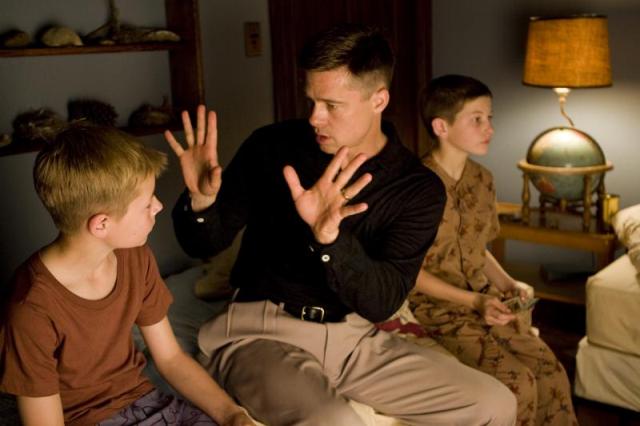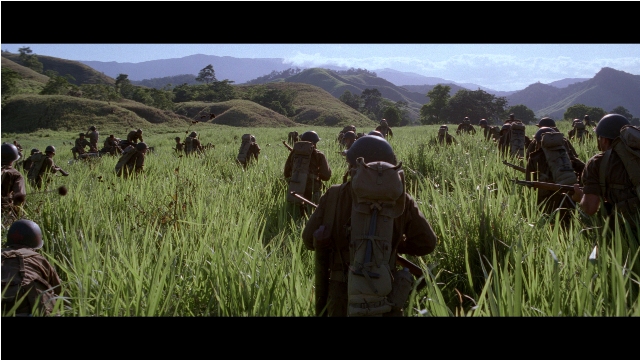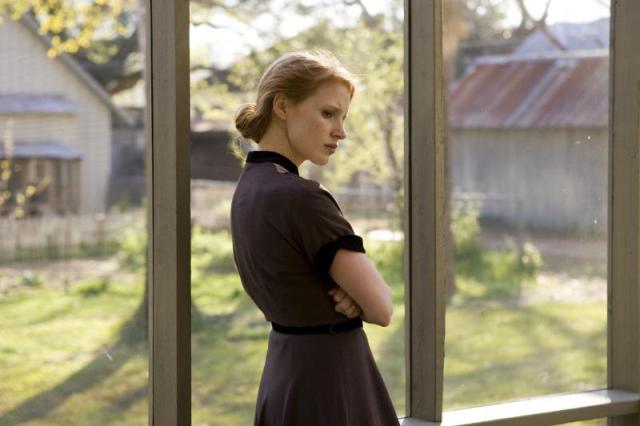CHICAGO – Patrick McDonald of HollywoodChicago.com audio review for the doc series “Charlie Hustle & the Matter of Pete Rose,” about the rise and bitter fall of the major league legend, the MLB’s all-time hits leader, only to be banned from the sport because of gambling. Streaming on MAX and on HBO since July 24th.
Film Feature: All Things Shine in Terrence Malick’s ‘The Tree of Life’
CHICAGO – “Where is it that we were together? Who were you that I lived with? The brother. The friend. Darkness, light. Strife and love. Are they the workings of one mind? The features of the same face? Oh, my soul. Let me be in you now. Look out through my eyes. Look at all the things you made. All things shining.”
These hardly appear to be the sort of words one would expect to end a war film. And yet, in the haunting final moments of Terrence Malick’s intimate WWII epic, “The Thin Red Line,” Pvt. Train (John Dee Smith) delivers these lines as if they were erupting out of his very soul. It’s the sort of poetic prose that only a bona-fide artist such as Malick could pull off without seeming pretentious. His entire oeuvre is poetry of the highest caliber, from the ever-exploring lens of his cameras to the meticulously prepared juxtapositions in his editing.
Yet Pvt. Train’s unforgettable monologue also reflects a major theme that is present throughout Malick’s work. Each of his five directorial efforts obsessively portrays the dichotomy of man in all of its contradictory facets. In his earlier work, this duality was mined for its inherent absurdities, which were best embodied by the character of Kit (Martin Sheen) in Malick’s masterful 1973 debut, “Badlands.” Kit’s high-minded beliefs about himself often conflicted with his own primal nature. One of the most darkly funny moments in the picture occurs when Kit rushes to hold the door for his weakened friend after impulsively shooting him in the back. When Linda (Linda Manz), the young narrator of Malick’s next feature, 1978’s “Days of Heaven,” observes her older brother engaging in decidedly uncivilized behavior, she surmises, “There was never a perfect person around. You just have half-angel, half-devil in you.” This single line set the tone for Malick’s subsequent work, leading all the way up to his magnum opus, “The Tree of Life,” now playing in theaters. It is easily the most personal film of the elusive director’s career, carrying echoes of his upbringing in Texas and his struggles with grief in the aftermath of his brother’s death. It is also the culmination of a project that Malick had begun developing in the days following “Heaven.”

Brad Pitt stars in Terrence Malick’s The Tree of Life.
Photo credit: Fox Searchlight Pictures
Malick’s early drafts for his unrealized film, “Q,” center on the creation of Earth itself. One of the most audacious aspects about “Life” is the way in which Malick effortlessly intertwines the evolution of a planet with a boy’s coming-of-age in 1950s-era Texas. Though the filmmaker has suggested that his footage of the cosmos will be re-edited into a correlative feature destined for IMAX screens, the scenes of Earth’s origins fit beautifully into this narrative. They equate the development of all life forms, regardless of their scope in the grand scheme of things. Much of Malick’s earlier work upstaged humans with overwhelming landscapes that rendered mankind humble and insignificant in the context of the universe. “Life” is a potent reminder of the universe that exists within every human being.
Not since Krzysztof Kieślowski has a filmmaker so consistently reawakened a viewer’s awe of existence. Malick’s love of innocence causes him to view the world’s wonders from a childlike perch, yet his work is the very opposite of naive. Therein lies the dichotomy. He has the command of craft that Stanley Kubrick once possessed, as well as the gift for improvisation practiced by independent auteurs the likes of John Cassavetes. The celestial effects, achieved reportedly without computers by a team including “2001: A Space Odyssey” mastermind Douglas Trumbull, are every bit as staggering as the unrehearsed moments miraculously captured on film (such as the instant a butterfly rests on the hand of actress Jessica Chastain).
It takes a very particular type of cinematographer to follow the restless mind of Malick during production, and Emmanuel Lubezki fits the bill. There is simply no one more adept at handling elegant long takes and inventive Stedicam work. He brings the audience directly to the level of Malick’s characters, peering through a child’s eyes to experience the hypnotic movement of bubbles, the ominous texture of DDT clouds, and the elation of playing “hide-and-seek.” Lubezki’s camerawork conveys each of these sensations with extraordinarily vivid detail. I can’t imagine any achievement in cinematography emerging this year that would be more deserving of every accolade. No wonder Malick signed him on for his next project, which is due out next year (the pair first collaborated on 2005’s “The New World”).

Terrence Malick’s 1998 war film The Thin Red Line shares striking similarities with his new film, The Tree of Life.
Photo credit: Fox 2000 Pictures
The sheer majesty of the film’s visual texture is a sight to behold, but it never distracts from the story’s philosophical or emotional core. Even the twenty minute sequence of Earth’s evolution fails to qualify as a disruption. It occurs immediately after the film’s somber opening moments, as a family comes to the realization that one of their closest members is no longer with them. The life of a 19-year-old boy has come to an end, though it’s unclear whether he was a casualty of war. His parents (Brad Pitt and Jessica Chastain) are beside themselves. We hear the voice of the deceased boy’s older brother, Jack (played by Hunter McCracken as a child and by Sean Penn as an adult), who speaks with a weathered voice wounded by disillusionment. That tone is reflected by his grieving mother, whose spiritual view of life has met its most devastating test. When a friend consoles her by saying that her son is now in God’s hands, she replies, “He was in God’s hands the whole time.” These opening moments provide the perfect introduction for the leap into space. It evokes the out-of-body experience one has after their foundation has been uprooted like the trunk of a tree. All it takes is a single shattering event to lead one to ponder the meaning of it all.
Once the film settles into the tale of Jack’s own evolution, the film reveals itself to be an ideal companion piece for Malick’s under-appreciated 1998 masterwork, “The Thin Red Line.” Both films take place on a battlefield, though in the case of “Life,” the war is one of ideas and the opposing armies are within the form of a mother and father. Mr. O’Brien’s worldview is both jaded and practical, whereas Mrs. O’Brien believes in the enriching power of grace. The father’s rigidity causes him to treat his children as if they were soldiers preparing for battle. He warns them of the dangers of being “too good,” whereas Chastain teaches them to find the good in all things. To Malick, their warring philosophies seem to represent the ultimate dichotomy of the human spirit. It’s hard to watch scenes of their verbal altercations and not be reminded of the similar discussions in “Line” that take place between Sean Penn and Jim Caviezel. In some ways, the adult Jack is an extension of Penn’s character in “Line,” as he finds himself becoming like the father he had always loathed. He floats through life like a ghost, searching for the spark that had once ignited his soul.

Jessica Chastain stars in Terrence Malick’s The Tree of Life.
Photo credit: Fox Searchlight Pictures
One wishes Chastain’s character had the same strength as Capt. Staros (Elias Koteas) in “Line,” when he quietly but firmly stood up to the enraged Lt. Col. Tall (Nick Nolte). There’s an equally powerful and agonizing scene in “Life” when Pitt physically restrains Chastain after she finally attempts to lash out against him. Earlier in the film, Malick finds an ingenious and unexpected way of illustrating that this method of domination had been around since the dawn of time. The 1950s suburb coupled with the domineering father is eerily evocative of Holly (Sissy Spacek), and her volatile home life in “Badlands.” Yet in terms of theme and approach, “Life” is most reminiscent of “Line,” since much of the dialogue is contained within hyper-articulate yet somewhat enigmatic voice-overs.
Pitt’s father is in the classic tradition of misguided Malick men whose efforts to control nature result in their own downfall. In a rare interview published by Beverly Walker in the Spring 1975 issue of “Sight and Sound” magazine, Malick admitted that he had a preference for female characters because “they’re more open to things around them, more demonstrative.” The director’s contrasting description of Kit in “Badlands” could easily apply to several of his subsequent male characters: “[He’s] a closed book, not a rare trait in people who have tasted more than their share of bitterness in life.” There are hints throughout “Life” that the bitterness plaguing Pitt’s character may stem from his unfulfilled dreams of becoming a musician.
Malick has always had a knack for eliciting uncharacteristically vulnerable work from actors usually typecast as alpha males (Paul Newman, Richard Gere, Colin Farrell), and Pitt’s splendid performance in “Life” is no exception. Chastain’s role is perhaps the trickier of the two, since Malick often frames her from the perspective of her adoring children, who initially see her as an ethereal being. But as played by Chastain (an actress clearly poised to become a major star), the character’s maternal warmth resonates on an entirely human level, and as her kids grow and mature, Malick allows her painful fragility to come into focus. The director’s magnificent track record with inexperienced child actors is upheld by McCracken’s heartbreaking performance, as well as the equally authentic work from Laramie Eppler and Tye Sheridan as his younger brothers.

Brad Pitt and Hunter McCracken star in Terrence Malick’s The Tree of Life.
Photo credit: Fox Searchlight Pictures
Mr. O’Brien’s yearning for music and his passion for old records enables Malick to assemble his most complex score to date. Though the film’s original music is by Alexandre Desplat, one of the best modern composers in the business, his subtle notes are used to create mood rather than melody. As usual, the songs destined to linger in the minds of moviegoers are the classical compositions and rare works brought to exhilarating new life by Malick. Who can forget the use of Carl Orff’s “Gassenhauer” in “Badlands,” Camille Saint-Saëns’ “Carnival of Animals” in “Days of Heaven,” the Melanesian choirs in “The Thin Red Line,” or R. Carlos Nakai’s performances of the Native American flute in “The New World”? That same magical frisson occurs in “Life” when Chastain points to the sky in an effort to locate God for her wide-eyed children, as Bedrich Smetana’s “Ma Vlast Moldau” swells. These pieces assist each film in acquiring a timelessness unbound by the period in which they are set or filmed.
Timeless may truly be the best way to describe the work of Terrence Malick, a cinematic Transcendentalist with an unflagging eagerness to take his audience on a journey into the unknown. It may be a tad premature to determine whether “The Tree of Life” is the best film of his career, though it is unquestionably the purest expression of his personal artistic voice. It may also be his most hopeful film. With another Malick movie set to premiere next year, this could be the most fertile creative period of the filmmaker’s career since the mid-’70s. Critics who have labeled “Life” as a simple-minded sermon have entirely missed the point. It has never been Malick’s intention to use cinema as a platform for preaching. There are no easy answers or clear cut messages in his work, only ideas worth entertaining and mysteries worth pondering. Watching one of his films may lead you to look back on your own life and find all things shining.
 | By MATT FAGERHOLM |


